Download as a PDF document
 Summary
Summary
In the United States, more than 300 million laying hens produce eggs, the majority of whom are confined in small, wire cages known as “battery cages.” These “battery hens” suffer from a number of debilitating welfare problems, including the thwarting of natural behaviors, bone weakness and breakage, feather loss, and numerous diseases.
The life of a battery hen begins in a commercial hatchery, where thousands of chicks are hatched in industrial incubators. Male chicks are of no value to the egg industry and are killed shortly after birth, usually by gassing, crushing, or suffocation. The female chicks have part of their beaks seared off with a hot blade. This “beak trimming” is performed without anesthesia or analgesia. Chickens have pain receptors in their beaks, and research has shown that hens likely experience both acute and chronic pain as a result of “beak trimming.” After this procedure, the chicks are transported to indoor egg farms and placed in battery cages.
Each wire battery cage normally houses three to ten hens. A typical U.S. egg farm contains thousands of cages at an average density of 59 square inches of space per bird (just over half the area of a letter-sized sheet of paper). Hens need an average of 72 square inches just to stand erect, 178 inches to preen, 197 inches to turn around, and 291 inches to flap their wings. Thus, hens in battery cages cannot perform any of these important natural behaviors, nor can they perch, preen, dustbathe, or nest. As a consequence, hens show signs of severe frustration and low welfare.
Battery cages contribute to a number of health problems, including uterine prolapse (when the uterus is pushed outside the body of a hen), foot disorders caused by the slanted wire floors of most battery cages, and Fatty Liver Hemorrhagic Syndrome. Because a large amount of calcium goes into egg production, almost all battery hens suffer from osteoporosis, which is exacerbated by lack of exercise in cages.
At the end of their laying cycle, most hens in U.S. egg factory farms are “forced molted,” or purposefully starved for 10 to 14 days, to induce another laying cycle. Forced molting can double the mortality of a flock and is believed to cause significant suffering among birds. After the second laying cycle, battery hens are gathered and transported to slaughter plants. At the plants, the hens are shackled by their legs and hung upside-down on a long conveyer belt. Shackling often breaks the hens’ fragile bones; by the time of slaughter, close to half of the birds have suffered broken bones. The hens are then submerged into an electrified water bath, which is supposed to render them unconscious, but many birds have their throats slit while fully conscious. Birds are not protected by the federal Humane Methods of Slaughter Act and are thus not required to be unconscious before being killed.
Standard industry practices cause battery hens to experience both acute and chronic pain. The treatment of these animals would be illegal if anti-cruelty laws applied to farmed animals. But, profits have taken priority over animal welfare.
Battery Cages
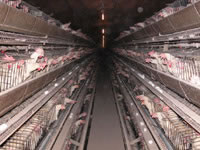 In the United States during 2002, 87 billion eggs were produced by roughly 336 million laying hens.(1) Ninety-eight percent of these hens were confined in battery cages.(2) These “battery hens” suffer from a number of debilitating welfare problems, including the thwarting of natural behaviors, bone weakness and breakage, feather loss, and numerous diseases. Battery cages are wire cages that normally house three to ten hens. A typical U.S. egg farm contains thousands of cages(3) at an average density of 59 square inches of space per bird.(4) Thus, each bird has an amount of space equivalent to just over half the area of a letter-sized sheet of paper. In 1999, the United Egg Producers (UEP), a trade association representing more than 85 percent of U.S. egg producers, created an Animal Husbandry Advisory Committee. The advisory group recommended that hens receive an average of 67 square inches of cage space per bird. UEP member producers are encouraged to gradually increase cage space per bird, in order to reach the recommended density of 67 inches, by 2008. However, even the new proposed standard is still less than a single sheet of letter-sized paper, an amount Dr. Joy Mench calls “meager.”(5) A study by Drs. M.S. Dawkins and S. Hardie (1989) found that hens need an average of 72 square inches just to stand erect, 178 inches to preen, 197 inches to turn around, and 291 inches to flap their wings.(6) Hens in battery cages cannot perform any of these important natural behaviors. Dr. Mench, a member of the UEP Animal Husbandry Guidelines Committee, said that “a different decision about the minimum recommendation would have been reached had the committee given more weight to the information from the preference testing and the use of space studies, since these indicate that hens need and want more space than 72 inches.”(7)
In the United States during 2002, 87 billion eggs were produced by roughly 336 million laying hens.(1) Ninety-eight percent of these hens were confined in battery cages.(2) These “battery hens” suffer from a number of debilitating welfare problems, including the thwarting of natural behaviors, bone weakness and breakage, feather loss, and numerous diseases. Battery cages are wire cages that normally house three to ten hens. A typical U.S. egg farm contains thousands of cages(3) at an average density of 59 square inches of space per bird.(4) Thus, each bird has an amount of space equivalent to just over half the area of a letter-sized sheet of paper. In 1999, the United Egg Producers (UEP), a trade association representing more than 85 percent of U.S. egg producers, created an Animal Husbandry Advisory Committee. The advisory group recommended that hens receive an average of 67 square inches of cage space per bird. UEP member producers are encouraged to gradually increase cage space per bird, in order to reach the recommended density of 67 inches, by 2008. However, even the new proposed standard is still less than a single sheet of letter-sized paper, an amount Dr. Joy Mench calls “meager.”(5) A study by Drs. M.S. Dawkins and S. Hardie (1989) found that hens need an average of 72 square inches just to stand erect, 178 inches to preen, 197 inches to turn around, and 291 inches to flap their wings.(6) Hens in battery cages cannot perform any of these important natural behaviors. Dr. Mench, a member of the UEP Animal Husbandry Guidelines Committee, said that “a different decision about the minimum recommendation would have been reached had the committee given more weight to the information from the preference testing and the use of space studies, since these indicate that hens need and want more space than 72 inches.”(7)
Nesting
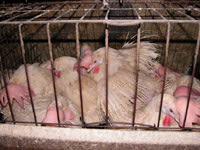 According to Dr. Ian Duncan, the most significant source of frustration for battery hens is “undoubtedly the lack of nesting opportunity.”(8) Every day, the hens search for a means and space to build a nest, as well as privacy they will never find, before being forced to lay their eggs on a metal-barred floor. According to Dr. Michael Baxter, this is likely to cause “significant suffering,”(9) and the hens show symptoms of “severe frustration,”(10) often throwing themselves against the bars of the cages or exhibiting stereotypical “pacing” when denied nesting materials and space. Dr. Mench has found that hens show a preference for nesting sites with litter, concealment, and protection for their nesting and incubation behaviors.(11) Battery cages provide none of these benefits.
According to Dr. Ian Duncan, the most significant source of frustration for battery hens is “undoubtedly the lack of nesting opportunity.”(8) Every day, the hens search for a means and space to build a nest, as well as privacy they will never find, before being forced to lay their eggs on a metal-barred floor. According to Dr. Michael Baxter, this is likely to cause “significant suffering,”(9) and the hens show symptoms of “severe frustration,”(10) often throwing themselves against the bars of the cages or exhibiting stereotypical “pacing” when denied nesting materials and space. Dr. Mench has found that hens show a preference for nesting sites with litter, concealment, and protection for their nesting and incubation behaviors.(11) Battery cages provide none of these benefits.
Reproductive Problems
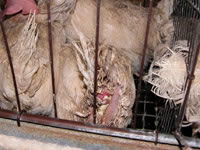 Uterine prolapse—a condition causing the uterus to be pushed outside of the hen’s body—is frequently seen in caged hens, since, without a nest, the birds are exposed after egg laying.(12) Dr. Susan Clubb urges a ban on battery cages, claiming that because the birds are bred to lay larger eggs in greater quantities, they are more susceptible to uterine prolapse.(13) Laying hens today lay an average of 240 to 250 eggs per year, many more than the roughly 25 eggs their ancestors, Red Junglefowl, lay in a year.(14) Selective breeding for more productive hens has also led to the expression of “genetic factors which increase death losses.”(15) In addition to laying larger eggs, the hens are also stressed by the use of artificial lighting to prolong laying hours. The hens’ uterus cannot withstand the constant exercise of egg-laying, exacerbated by the above factors, and uterine prolapse often results.(16)
Uterine prolapse—a condition causing the uterus to be pushed outside of the hen’s body—is frequently seen in caged hens, since, without a nest, the birds are exposed after egg laying.(12) Dr. Susan Clubb urges a ban on battery cages, claiming that because the birds are bred to lay larger eggs in greater quantities, they are more susceptible to uterine prolapse.(13) Laying hens today lay an average of 240 to 250 eggs per year, many more than the roughly 25 eggs their ancestors, Red Junglefowl, lay in a year.(14) Selective breeding for more productive hens has also led to the expression of “genetic factors which increase death losses.”(15) In addition to laying larger eggs, the hens are also stressed by the use of artificial lighting to prolong laying hours. The hens’ uterus cannot withstand the constant exercise of egg-laying, exacerbated by the above factors, and uterine prolapse often results.(16)
Dustbathing and Perching
 Battery hens are unable to dustbathe, perch, forage, or roost—natural behaviors which are replaced by inactivity on the barren cage floors. Under normal conditions, hens regularly bathe in dust to keep their feathers in good condition, as well as to regulate their temperature.(17) Caged hens still retain the natural urge to dustbathe, even when the stimulus of litter is not present.(18) In fact, battery hens will try to dustbathe against the wire bars of the cage.(19) This only leads to the further degradation of feather condition.(20)
Battery hens are unable to dustbathe, perch, forage, or roost—natural behaviors which are replaced by inactivity on the barren cage floors. Under normal conditions, hens regularly bathe in dust to keep their feathers in good condition, as well as to regulate their temperature.(17) Caged hens still retain the natural urge to dustbathe, even when the stimulus of litter is not present.(18) In fact, battery hens will try to dustbathe against the wire bars of the cage.(19) This only leads to the further degradation of feather condition.(20)
Dr. Baxter states that hens without access to perches are shown to suffer reduced welfare from “increased aggression, reduced bone strength, impaired food condition and high feather loss.”(21) Studies such as that by Drs. L.S. Cordiner and C.J. Savory have shown that supplementing cages with perches “reduces antagonistic interactions,” by providing the means to form a hierarchy natural among laying hens.(22) The floors of battery cages themselves present larger problems, leading to foot and leg problems for the hens.
Because chickens’ toes have evolved to grasp tree limbs and other natural perches, tendon tension causes a high incidence of crooked toes, a severely painful condition, when wire floors are used.(23) Since cage floors are slanted to facilitate egg collection, hens may slip, causing calluses that can rupture and become infected.(24) Research shows that hens in cages have a higher incidence of foot damage than those living in litter.(25, 26)
Feather Loss
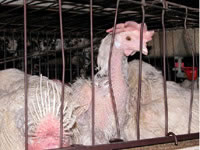 Many birds show signs of feather loss in battery cages. Feather pecking by other birds because of close confinement poses one of the largest problems. A 2001 study found that feather pecking is greatly reduced in chicks who have early access to litter, regardless of later conditions.(27) In the study, there was a significant reduction in both feather pecking and feather damage in chicks who had access to litter in the first two weeks of life. Because nearly all caged laying hens spend their entire lives confined on metal flooring, even selective breeding against pecking may have less of an impact than access to litter. Feather pecking may also be caused by exposure to long periods of light. Dr. Philip J. Clauer warns that “constant light can be stressful to the birds.”(28)
Many birds show signs of feather loss in battery cages. Feather pecking by other birds because of close confinement poses one of the largest problems. A 2001 study found that feather pecking is greatly reduced in chicks who have early access to litter, regardless of later conditions.(27) In the study, there was a significant reduction in both feather pecking and feather damage in chicks who had access to litter in the first two weeks of life. Because nearly all caged laying hens spend their entire lives confined on metal flooring, even selective breeding against pecking may have less of an impact than access to litter. Feather pecking may also be caused by exposure to long periods of light. Dr. Philip J. Clauer warns that “constant light can be stressful to the birds.”(28)
Hens may also experience feather loss due to the thwarted desire to dustbathe, as discussed earlier. Behavioral consequences, such as repeatedly throwing themselves against the cage bars, can contribute to feather loss on the body of the hens.(29) Research has also shown that feathers may not develop due to a deficiency in the crucial amino acid methionine.(30)
Bone Weakness
Battery hens are typically kept inside environment-controlled houses and never see sunlight. Vitamin D is necessary for the absorption of calcium, and its production is triggered by sunlight.(31) Although hens are fed supplementary vitamin D, many still suffer from osteoporosis. Much of the hens’ calcium is used to produce the shells of their eggs, thereby reducing the amount of calcium available for bone maintenance. Bone weakness is exacerbated by the hens’ lack of exercise in battery cages.(32) One study found that 89 percent of laying hens suffered from osteoporosis.(33) It is estimated that even before capture and transport, one in six hens suffer from broken bones.(34) Dr. Baxter states that “hens are restricted from exercising to such an extent that they are unable to maintain the strength of their bones. The increased incidence of bone breakage which results is a serious welfare insult.”(35) Research has shown that the type of housing, such as aviary, perchery, or enriched cage, also has an influence on bone strength.(36) Dr.A.B. Webster concludes that “those housing systems that foster the greatest physical activity produce hens with the strongest bones.”(37)
Liver Damage
Fatty liver hemorrhagic syndrome is “the major cause of mortality in laying hens.”(38) The disease is characterized by excessive fat deposits and enlarged livers. Sudden death occurs among overweight laying hens by a massive hemorrhage. This occurs as a result of excess energy consumption, often after forced molting (see below), when caloric intake is high, and can also be affected by excessive estrogen and certain diets. Caged laying hens producing large numbers of eggs are the most frequently affected by this disease.(39)
Beak-Trimming
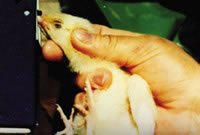 Most laying hens in the United States are “beak-trimmed.”(40) This procedure, in which part of the beak of a young chick is seared off with a hot blade, is performed without anesthesia or analgesia.(41-43) It has been shown that this results in both acute and chronic pain.(44, 45) Because severed nerves partially re-grow in the bird’s beak, studies have equated the pain to that of a phantom limb.(46)
Most laying hens in the United States are “beak-trimmed.”(40) This procedure, in which part of the beak of a young chick is seared off with a hot blade, is performed without anesthesia or analgesia.(41-43) It has been shown that this results in both acute and chronic pain.(44, 45) Because severed nerves partially re-grow in the bird’s beak, studies have equated the pain to that of a phantom limb.(46)
Chickens use their beaks to explore their surroundings. Their beaks are their primary means of touching and feeling, as well as for picking up objects. After their beaks are trimmed, both chicks and adults exhibit great difficulty in grasping and swallowing feed.(47) The egg industry claims that beak trimming is needed both to decrease aggressive tendencies among birds and to reduce feed costs.(48)
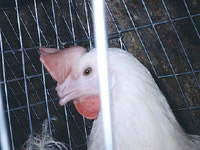 However, aggression among caged hens has been proven to be rare in occurrence, and, in any case, beak trimming does not decrease aggressive tendencies.(49) Therefore, beak trimming is performed principally because it reduces “food flicking, food wastage, and food consumption.”(50) The procedure is seen by Dr. Mench as a “stop-gap measure masking basic inadequacies in environment or management.”(51) Banned in some European countries, the procedure has been proven unnecessary, as many including Dr. Duncan say that “it is possible to manage hens without debeaking them.”(52)
However, aggression among caged hens has been proven to be rare in occurrence, and, in any case, beak trimming does not decrease aggressive tendencies.(49) Therefore, beak trimming is performed principally because it reduces “food flicking, food wastage, and food consumption.”(50) The procedure is seen by Dr. Mench as a “stop-gap measure masking basic inadequacies in environment or management.”(51) Banned in some European countries, the procedure has been proven unnecessary, as many including Dr. Duncan say that “it is possible to manage hens without debeaking them.”(52)
Forced Molting
As hens age, egg production slows. In order to induce higher egg production, most hens are “forced molted”—purposely starved for 10 to 14 days, until 30 percent of body weight is lost—to induce feather growth and egg production.(53, 54) UEP Guidelines do not prohibit forced molting through starvation. The withdrawal of food “has both metabolic and behavioral consequences for poultry,” according to Dr. Mench.(55) During forced molting through feed withdrawal, the hens exhibit a classical physiological stress response, as well as signs of “extreme distress such as increased aggression and the formation of stereotyped pacing.”(56, 57) Dr. Duncan considers the practice “barbaric,”(58) as it can double the mortality of the flock, and leads to “enormous” suffering. Dr. Webster states that forced molting by the method of feed withdrawal “imposes complete calcium deprivation and causes a very rapid decline in bone strength while hens remain in production.”(59)
Male Chicks
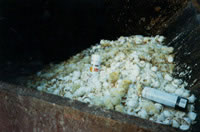 Male chicks do not lay eggs and, because they are of a different breed than “broiler” chickens raised for meat, have no economic value to the egg industry. They are likewise considered an unwanted by-product of egg production and are killed shortly after birth. In 1998, 219 million chicks were killed by the commercial egg industry.(60) They are typically ground up alive, gassed, or thrown into a dumpster to suffocate or dehydrate.(61, 62)
Male chicks do not lay eggs and, because they are of a different breed than “broiler” chickens raised for meat, have no economic value to the egg industry. They are likewise considered an unwanted by-product of egg production and are killed shortly after birth. In 1998, 219 million chicks were killed by the commercial egg industry.(60) They are typically ground up alive, gassed, or thrown into a dumpster to suffocate or dehydrate.(61, 62)
Catching and Transport
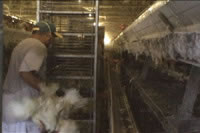 |
| East Bay Animal Advocates |
After laying hens have reached the end of their first or second laying cycle (depending on whether or not they had been force molted), the “spent” birds are transported to the slaughter plant. Teams of catchers take the birds from their cages and put them in crates that are stacked and loaded onto a truck. Human handling is a known stressor for chickens, as seen by the fast rise in corticosterone levels immediately following catching.(63) The catching teams work at a rate of 1,000 to 1,500 birds per hour, sometimes holding seven birds at a time.(64) The battery cage is poorly designed for hen removal, and limbs and appendages are often torn when the birds are being removed.(65) After a life of laying eggs, the hens’ bodies are ravaged, with bones weakened by calcium loss and inactivity. Dr. Duncan states that “the combination of these three factors—fragile skeleton, poorly designed cage, and low value—results in an unacceptably high injury level” during transport.(66)
Mortality and injury due to capture and transport were found to be the highest among spent laying hens. Drs. N.G. Gregory and L.J. Wilkins found that “24% of hens had broken bones after commercial depopulation; bone breakage increased by 44% when the birds were removed and hung on shackles.”(67) The main causes of trauma during capture and transport are: dislocated or broken hips (76%), liver hemorrhage (11%), head trauma (8%), and other causes (5%).(68)
Because only a few processing plants in the United States accept spent hens, the birds often must endure long journeys, during which they may be in pain for significant periods.(69) On the transport trucks, the hens suffer from thermal stress, as birds in the center of trucks tend to overheat, while birds on the outsides are unprotected from the elements.(70) The federal Twenty-Eight Hour Law “provides that animals cannot be transported across state lines for more than 28 hours�without being unloaded for at least five hours of rest, watering, and feeding.”(71) However, the law only applies to travel by rail, while virtually all poultry transport in the United States is by truck, which the U.S. Department of Agriculture explicitly states is not covered by the law.(72) During transport, some hens die, usually from congestive heart failure due to the stresses of handling and transport.(73)
Slaughter
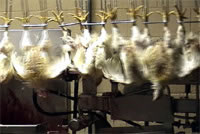 Birds are not protected by the federal Humane Methods of Slaughter Act.(74) Dr. John Boyce wrote that the egg industry and the American Veterinary Medical Association “oppose humane slaughter legislation for laying hens on the basis that their low economic value does not justify the cost of ‘humane slaughter technology.'”(75) Dr. Duncan states that “of all the animal welfare problems faced by the poultry industry today, the disposal of spent laying hens probably is the most serious.”(76)
Birds are not protected by the federal Humane Methods of Slaughter Act.(74) Dr. John Boyce wrote that the egg industry and the American Veterinary Medical Association “oppose humane slaughter legislation for laying hens on the basis that their low economic value does not justify the cost of ‘humane slaughter technology.'”(75) Dr. Duncan states that “of all the animal welfare problems faced by the poultry industry today, the disposal of spent laying hens probably is the most serious.”(76)
At the slaughter facility, the hens are shackled by their legs and hung upside-down, a process which breaks bones and causes bruising and stress.(77) The weakened bones of the hens make it “difficult to shackle the bird properly without causing pain.”(78) The birds are then stunned in an electrified water bath, which is supposed to render them unconscious. Because tetany and muscular spasms accompany electrical stunning and can cause further bone breakage, the intensity of the stun is often reduced. This raises the risk of improper stunning before slaughter.(79) Other variables, such as size differences and conductivity of individual birds, also affect the success of the stunning process.(80) As a result, many smaller birds are slaughtered without being stunned, because they do not reach the water of the electrical bath.(81)
The hens are then passed over a circular blade, which slits their throats. After fully bleeding, they are put in the “scalding tank” in order to loosen feathers. If the hens are not properly stunned, there is a greater chance of them missing the cutting blade, resulting in birds entering the scalding tank alive and conscious.(82, 83)
Many solutions to the problem of the disposal of spent laying hens have been suggested. Most methods involve killing the birds on the farm, but, to date, none has proven effective.(84) The least inhumane method would be to gas the hens while still in their cages with an argon mixture, but this presents the problem of removal once the bodies have become stiffened by rigor mortis. Drs. Webster and D.L. Fletcher have suggested the development of a portable gas stunning and killing cabinet, into which the hens could be placed upon removal from their cages.(85) However, all methods performed on the farm render the birds unfit for human consumption, which means their bodies would need to be composted. This appears very wasteful to the public, and the egg industry is reluctant to impose any of these alternatives.(86)
Conclusion
 |
| Rescued by COK |
The egg industry holds that laying hens are humanely raised and truly content in battery cages. An article entitled “Perspective” in Egg Industry magazine stated that “today we have a 252 egg average cycle, and that’s ordinary. Can you imagine unhappy chickens laying that many eggs?”(87) However, Dr. Mench says, “It is now generally agreed that good productivity and health are not necessarily indicators of good welfare�.[I]ndividual animals may be in a comparatively poor state of welfare even though productivity within the unit may be high.”(88) Ken Klippen, spokesperson for the United Egg Producers, stated in a television interview, “The research showed it was humane to have chickens in cages. In fact, they would prefer to be in cages.”(89) In fact, no published studies could be found supporting this claim. There is an abundance of research, much of it cited in this report, demonstrating that hens kept in battery cages experience greatly reduced welfare.
Indeed, these birds are more intensively confined than any other farmed animal and endure an immense amount of suffering.
Works Cited
- USDA – National Agricultural Statistics Service, “Poultry Highlights” May 29, 2002,http://www.nass.usda.gov/ca/rev/poultry/205polna.htm.
- United Egg Producers – “United Egg Producers Animal Husbandry Guidelines for U.S. Egg Laying Flocks,” 2002 Edition (United Egg Producers, Alpharetta, Ga.).
- Fraser D, Mench J, and Millman S, “Farm Animals and Their Welfare in 2000,” State of the Animals 2001 (Washington DC: Humane Society Press, 2001), 89.
- United Egg Producers, op. cit., 12.
- Fraser D, Mench J, and Millman S, op. cit., 90.
- Mench J and Swanson J, “Developing Science-Based Animal Welfare Guidelines,” a speech delivered at the 2000 Poultry Symposium and Egg Processing Workshop,http://animalscience.ucdavis.edu/Avian/pubs.htm.
- Mench J and Swanson J, op. cit.
- Duncan IJH, “The Pros and Cons of Cages,” World�s Poultry Science Journal 57 (2001): 385.
- Baxter M, “The Welfare Problems of Laying Hens in Battery Cages,” The Veterinary Record134 (1994): 618.
- Duncan IJH, “Animal Welfare Issues in the Poultry Industry: Is There a Lesson to Be Learned?” Journal of Applied Animal Welfare Science 4 (2001): 207-21.
- Mench J, “The Welfare of Poultry in Modern Production Systems,” Poultry Science Review 4 (1992): 112.
- North M and Bell D, Commercial Chicken Production Manual, 4th Edition (New York, Van Nostrand Reinhold, 1990), 366.
- Clubb S, “Stop the Practice of Starving Birds for Egg Production,” Association of Avian Veterinarians Newsletter, June-August 2001.
- Arshad M, “An Ecological Study of Red Junglefowl (Gallus gallus spadiceus) in Agricultural Areas,” Universiti Putri Malasia, 1999.
- Wolfson D, Beyond the Law: Agribusiness and the Systemic Abuse of Animals Raised for Food or Food Production (Farm Sanctuary, Inc., 1999), 26.
- Keshavarz K, “Causes of Prolapse in Laying Flocks,” Poultry Digest Sept. 1990: 42.
- Van Liere D and Bokma S, “Shorter Feather Maintenance as a Function of Dust-Bathing in Laying Hens,” Applied Animal Behaviour Science 18: 197-204.
- Mench J, op. cit.
- Vestergaard K, “Dusbathing of Hens with and without Access to Sand,” Applied Animal Behaviour Science 17 (1987): 380.
- Simonsen H, Vestergaard K, and Willeberg P, “Effect of Floor Type and Density on the Integument of Egg Layers,” Poultry Science 59 (1980): 2202-6.
- Baxter M, op. cit.
- Cordiner LS and Savory CJ, “Use of Perches and Nestboxes by Laying Hens in Relation to Social Status, Based on Examination of Consistency of Ranking Orders and Frequency of Interaction,” Applied Animal Behaviour Science 71(2001): 305-17.
- “Crooked Toes,” Merck Veterinary Manual Online, 8th Edition, 2003,http://www.merckvetmanual.com/mvm/htm/bc/205102.htm.
- Duncan IJH, “Animal Welfare Issues in the Poultry Industry,” op. cit.
- Simonsen H, Vestergaard K, and Willeberg P, op. cit.
- Appleby M, “Do Hens Suffer in Battery Cages?” A Review of the Scientific Evidence Commissioned by the Athene Trust, 1991.
- Huber-Eicher B and Sebo F, “Reducing Feather Pecking When Raising Laying Hen Chicks in Aviary Systems,” Applied Animal Behavioural Science 73 (2001): 59-68.
- Clauer P, “Cannibalism: Prevention and Treatment,” Poultry Extension Specialist Animal and Poultry Science Department, http://www.thepoultrysite.com/FeaturedArticle/FATopic.asp?Display=180.
- Vestergaard K, “Alternative Farm Animal Housing: Ethological Considerations,” Scientists Center Newsletter 9.3 (1987): 10.
- “Poultry: Causes of Poor Feathering,” Mississippi State University Extension Service Online, 2003, http://msucares.com/poultry/diseases/poultry_feathers.html.
- “Vitamin D,” Linus Pauling Institute Micronutrient Information Center,http://lpi.oregonstate.edu/infocenter/vitamins/vitaminD/index.html.
- Duncan IJH, “Animal Welfare Issues in the Poultry Industry,” op. cit.
- Webster AB, “Welfare Implications of Avian Osteoporosis,” 2004 Poultry Science 83: 184-92.
- Parkinson G, “Osteoporosis and Bone Fractures in the Laying Hen,” Progress Report of Work at the Victorian Institute of Animal Science, Attwood, 1993.
- Baxter M, op. cit.
- Webster AB, op. cit.
- Ibid.
- Cherian G, “Fatty Liver Hemorrhagic Syndrome in Laying Hens: An Investigation into the Role of Dietary Fatty Acids,” USDA Current Research Information System (CRIS).
- “Fatty Liver Syndrome: Introduction,” Merck Veterinary Manual Online, 8th Edition, 2003,http://www.merckvetmanual.com/mvm/htm/bc/202500.htm.
- Duncan IJH, “Animal Welfare Issues in the Poultry Industry,” op. cit.
- Mench J, op. cit.
- United Egg Producers, op. cit.
- Duncan IJH, “Animal Welfare Issues in the Poultry Industry,” op. cit.
- Mench J, op. cit.
- Duncan IJH, “Animal Welfare Issues in the Poultry Industry,” op. cit.
- Ibid.
- Mench J, op. cit.
- “Feed savings could justify beak trimming,” Poultry Digest, March 1993: p. 6. As cited in Davis K, Prisoned Chickens, Poisoned Eggs: An Inside Look at the Modern Poultry Industry(Summertown, TN: The Book Publishing Co., 1996), p. 70.
- Mench J, op. cit.
- Poultry Digest, 1993, op. cit., p.6.
- Fraser D, Mench J, and Millman S, op. cit., p.94.
- Duncan IJH, Letter dated June 25, 2003, to Dr. Nancy Halpern, New Jersey Department of Agriculture.
- Fraser D, Mench J, and Millman S, op. cit., p.94.
- Duncan IJH, “Animal Welfare Issues in the Poultry Industry,” op. cit.
- Mench J, op. cit.
- Duncan IJH, “Animal Welfare Issues in the Poultry Industry,” op. cit.
- Mench J, op. cit.
- Duncan IJH, Letter, op. cit..
- Webster AB, op. cit.
- Fraser D, Mench J, and Millman S, op. cit., p.90.
- MacArthur M, “Analyst Says Poultry Growers Oblivious to Poor,” Western Producer, Dec. 12, 2002, http://www.producer.com/articles/20021212/news/20021212news19.html.
- Fraser D, Mench J, and Millman S, op. cit., p.90.
- Mench J, op. cit.
- Estevez I, “Poultry Welfare Issues,” Poultry Digest Online 3 (2002): number 2.
- Duncan IJH, “Animal Welfare Issues in the Poultry Industry,” op. cit.
- Ibid.
- Mench J, op. cit.
- Estevez I, op. cit.
- Duncan IJH, “Animal Welfare Issues in the Poultry Industry,” op. cit.
- Estevez I, op. cit.
- Wolfson D, op. cit., p. 13.
- 60 Federal Rule 48362. The rule states: “The Twenty-Eight Hour Law does not apply to transport by truck.”
- Estevez I, op. cit.
- Duncan IJH, “Animal Welfare Issues in the Poultry Industry,” op. cit.
- Boyce, John R, D.V.M., Assistant Director, Division of Scientific Activities, American Veterinary Medical Association, letter to Karen Davis, Ph.D., Dec. 15, 1992.
- Duncan IJH, “Animal Welfare Issues in the Poultry Industry,” op. cit.
- Estevez I, op. cit.
- Ibid.
- Duncan IJH, “Animal Welfare Issues in the Poultry Industry,” op. cit.
- Duncan IJH, “Animal Welfare Issues in the Poultry Industry,” op. cit.
- Estevez I, op. cit.
- Duncan IJH, “Animal Welfare Issues in the Poultry Industry,” op. cit.
- Estevez I, op. cit.
- Duncan IJH, “Welfare Problems of Poultry,” In: Benson GJ and Rollin BE, eds., The Well-Being of Farm Animals: Challenges and Solutions (Ames: Blackwell, 2004), 307-19.
- Ibid.
- Ibid.
- Wentink H, “Perspective,” Egg Industry, March/Aprril 1993.
- MenchJ , op. cit.
- Klippen K, United Egg Producers, on WTTG-Fox 5 News, February 23, 2003.

